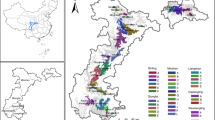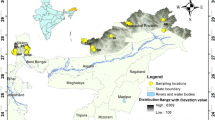Abstract
The endangered giant panda (Ailuropoda melanoleuca) is endemic to the mountains of Sichuan, Gansu and Shaanxi Provinces in China. The species had numbered over 2000 animals in early 1970s, but declined to no more than 1,000 animals fragmented into perhaps 32 subpopulations in late 1990s as the result of numerous detrimental forces such as habitat shrinking, poaching and bamboo flowering. The mass flowering and followed die-off of bamboo played key roles in the declination of panda population in the past three decades. It trigged the starvation and following high mortality of giant pandas in 1970s over Min Mountains and in 1980s across Qionglai Mountains in Sichuan Province. The situation of survivorship is made worse by the fact that the panda habitat is fragmented into many small “islands”, each containing only a few pandas. Such small, isolated panda populations are rendered even more volnerable to extinction form threats such as habitat degradation, natural disaster, disease, and the deleterious effects of inbreeding. So restoring the panda habitat and reintroduction pandas to their historical habitat might be an important issue for protecting the giant panda in wild.
Similar content being viewed by others
References
Cart, J., Ackleh, A.S., Leonard, B.P., Wang, B. 1999. Giant panda (Ailuropoda melanoleuca) population dynamics and bamboo (subfamily Bambusoideae) life history: a structured population approach to examining carrying capacity when the prey are semelparous [J]. Ecological Modelling,123: 207–223
Cheng, L.X., Liu, X.H., Fu, B.J. 1999. Evaluation on giant panda habitat fragmentation in Wolong Nature Reserve [J]. ACTA Ecologica Sinica,19(3): 291–297 (in Chinese)
Fang, S.G., Feng, W.H., Zhang, A.J., Li, G.H., 1999. The numbers and genetic diversity of giant panda in Xiangling mountain by DNA finger printing [J]. Journal of Sichuan University (Natural Science Edition),36(3): 627–630
Fish and Wildlife Service (U.S.), 1998. Policy on Giant Panda Permits.
Guo, J., Hu, J.C. 1999a. The population density of the giant panda and the protection countermeasure in Yele Nature Reserve [J]. Journal of Nanjing Forestry University,23(5): 27–30 (in Chinese)
Guo J., Hu, J.C. 1999b. The population viability analysis of giant panda in Yele area [J]. Journal of Nanjing Forestry University,23(6): 29–32 (in Chiense)
He, F. 1998. Interview of Professor Feng Wenhe in Sichuan Union University [J]. Sichuan Journal of Zoology,17(4): 54 (in Chinese)
Hu, J.C. 1985. Giant panda of Wolong [M]. Chengdu: Sichuan Publish House of Technology and Science.
Jien, G. 1991. Alluropoda melanoleuca. IUCN/SSC Bear Specialist Group Newsietter. (2).
Lindburg, D. 1999. State of the panda speech [R], Zoological Society of San Diego, February 12, 1999
Ma, Y.S. 1999. The distribution and protection of giant panda in Talbaishan [J]. Chinese Journal of Zoology, (4): 32–35 (in Chinese)
MacKinnon, J., De Wulf, R. 1994. Designing protected areas for giant pandas in China [C]. In: Miller, R.I. (ed). Mapping the Diversity of Nature. London: Chapman and Hall, 127–142.
Menghu, W., and Tieqin, H. (eds.). 1989. National Conservation Management Plan for the Giant Panda and its Habitat: Sichuan, Shaanxi and Gansu Provinces, The People’s Republic of China [R]. Joint Report of the WWWF&Ministry of Forestry of the People’s Republic of China.
O’Brein, S.J., Knight, J.A. 1987. The future of giant panda [J]. Nature,325: 758–759.
Ou, F.H., Xian, F.H., Cheng, W.L., Liu, X.G.,et al. 1999. Group quantity and habitat movement of giant panda in tianjiahe Nature Reserve [J]. Sichuan Journal of Zoology,18(2): 89–91 (in Chinese)
Pan, W.S. 1998. Preserving the Giant Pandas of the Qinling Mountain Areas. In China 2000-Giant Panda
Reid, D.G., Hu, J.C., Dong S., Wang, W., Huang, Y., 1989. Giant panda Ailuropoda melanoleuce behaviour and carrying capacity following a bamboo die-off. Biological Conservation, 49, 85–104
Reid, D.G., Hu, J.C. 1991. Giant panda selection between Bashynia fangiana bamboo habitat in Wolong Reserve, Sichuan [J]. China. Journal of Applied Ecology,28: 228–243
Schaller, G.B., Hu, J.C., Pan, W.S.et al. 1985. The Giant Panda of Wolong. University of Chicago press
Schaller, G.B., 1987. Bamboo shortage not the only cause of panda decline [J]. Nature,327: 562
Sichuan Daily, 1999. Home of giant panda: Fengtongshai. Sichuan Daily, June 25, 1999 (in Chinese)
Taylor, A.H., Qin, Z.S., Hu, J.C. 1991. Bamboo dieback: an opportunity to restore panda habitat. Environmental Conservation [J].18(2): 166–168
Taylor, A.H., Qin, Z.S. 1993. Bamboo regeneration after flowering in the Wolong Giant Panda Reserve [J], China. Biological Conservation,63: 231–234
Wei, F.W., Feng, Z.J., Wang, Z.W. 1999. Habitat selection by giant panda and red panda in Xiangling Mountains [J]. ACTA Zoologic Sinica,45(1): 57–64 (in Chinese)
Zhang, H.M., Yang, J., Tan, Y.C., Wei, Y.P., 1999. The ecological features ofAiluropoda melanoleuca’s habitat in the Wolong Nature Reserve and their mutual relation betweenAiluropoda melanoleuca and its ecological features [J]. Sichuan Forestry Exploration and design, (1): 16–23 (in Chinese)
Zhang, H.M., Yang, Y.P., Zhang, G.Q., Wei, Y.P. 2000. Advances in conservation and research technology for capitive and wild pandas of Wolong [J]. Sichuna Journal of Zoology,19(1): 35–38 (in Chinese)
Zhao, H.D., Yong, Y.G., Zhao, N.X., Yuan, Y.Q.,et al. 1999. An report of animal survey in Fuping Nature Researve [J]. Shaanxi Forest Science and Technology,1(1): 58–61.
Author information
Authors and Affiliations
Additional information
Responsible editor: Chai Ruihai
Rights and permissions
About this article
Cite this article
Zhao-hua, L., Denich, M. An approach on the survivorship of giant panda in wild. Journal of Forestry Research 12, 59–62 (2001). https://doi.org/10.1007/BF02856803
Received:
Issue Date:
DOI: https://doi.org/10.1007/BF02856803




